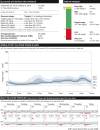Continuous Glucose Monitoring to Optimize Management of Diabetes in Patients with Advanced CKD
- PMID: 36719162
- PMCID: PMC10101590
- DOI: 10.2215/CJN.04510422
Continuous Glucose Monitoring to Optimize Management of Diabetes in Patients with Advanced CKD
Abstract
Treatment of patients with diabetes and CKD includes optimizing glycemic control using lifestyle modifications and drugs that safely control glycemia and improve clinical kidney and cardiovascular disease outcomes. However, patients with advanced CKD, defined as eGFR <30 ml/min per 1.73 m2 or kidney disease treated with dialysis, have limitations to the use of some preferred glucose-lowering medications, are often treated with insulin, and experience high rates of severe hypoglycemia. Moreover, hemoglobin A1c accuracy decreases as GFR deteriorates. Hence, there is a need for better glycemic monitoring tools. Continuous glucose monitoring allows for 24-hour glycemic monitoring to understand patterns and the effects of lifestyle and medications. Real-time continuous glucose monitoring can be used to guide the administration of insulin and noninsulin therapies. Continuous glucose monitoring can overcome the limitations of self-monitored capillary glucose testing and hemoglobin A1c and has been shown to prevent hypoglycemic excursions in some populations. More data are needed to understand whether similar benefits can be obtained for patients with diabetes and advanced CKD. This review provides an updated approach to management of glycemia in advanced CKD, focusing on the role of continuous glucose monitoring in this high-risk population.
Copyright © 2022 by the American Society of Nephrology.
Conflict of interest statement
R.J. Galindo reports consultancy agreements with Eli Lilly, Sanofi, Pfizer, Boehringer-Ingelheim, Merck, and Weight Watchers and research support to Emory University for studies from Dexcom, Eli Lilly, and Novo Nordisk. I.H. de Boer reports consultancy agreements with AstraZeneca, Bayer, Boehringer-Ingelheim, Boehringer-Ingelheim/Lilly, Cyclerion Therapeutics, George Clinical, Gilead, Goldfinch Bio, Ironwood Pharmaceuticals, Medscape, and Otsuka; research funding from DexCom; honoraria from the National Institutes of Health; and serving as a deputy editor of
Figures




Similar articles
-
Hypoglycemia in People with Type 2 Diabetes and CKD.Clin J Am Soc Nephrol. 2019 Jun 7;14(6):844-853. doi: 10.2215/CJN.11650918. Epub 2019 Apr 17. Clin J Am Soc Nephrol. 2019. PMID: 30996047 Free PMC article.
-
Use of Continuous Glucose Monitoring in the Assessment and Management of Patients With Diabetes and Chronic Kidney Disease.Front Endocrinol (Lausanne). 2022 Apr 22;13:869899. doi: 10.3389/fendo.2022.869899. eCollection 2022. Front Endocrinol (Lausanne). 2022. PMID: 35528010 Free PMC article. Review.
-
Beyond HbA1c.J Diabetes. 2017 Dec;9(12):1052-1053. doi: 10.1111/1753-0407.12590. Epub 2017 Sep 13. J Diabetes. 2017. PMID: 28792665
-
Glycemic Monitoring and Management in Advanced Chronic Kidney Disease.Endocr Rev. 2020 Oct 1;41(5):756-74. doi: 10.1210/endrev/bnaa017. Endocr Rev. 2020. PMID: 32455432 Free PMC article. Review.
-
Monitoring glycemia in diabetes.Med Clin North Am. 2015 Jan;99(1):35-45. doi: 10.1016/j.mcna.2014.08.017. Epub 2014 Oct 16. Med Clin North Am. 2015. PMID: 25456642 Review.
Cited by
-
Continuous Glucose Monitoring Metrics and Hemoglobin A1c Relationship in Patients with Type 2 Diabetes Treated by Hemodialysis.Diabetes Technol Ther. 2024 Nov;26(11):862-868. doi: 10.1089/dia.2024.0145. Epub 2024 Jun 14. Diabetes Technol Ther. 2024. PMID: 38805310
-
Current barriers to initiating insulin therapy in individuals with type 2 diabetes.Front Endocrinol (Lausanne). 2024 Mar 14;15:1366368. doi: 10.3389/fendo.2024.1366368. eCollection 2024. Front Endocrinol (Lausanne). 2024. PMID: 38559691 Free PMC article. Review.
-
Glycated Albumin and Adverse Clinical Outcomes in Patients With CKD: A Prospective Cohort Study.Am J Kidney Dis. 2024 Sep;84(3):329-338. doi: 10.1053/j.ajkd.2024.02.006. Epub 2024 Mar 20. Am J Kidney Dis. 2024. PMID: 38518919
-
Consensus Report on the Use of Continuous Glucose Monitoring in Chronic Kidney Disease and Diabetes.J Diabetes Sci Technol. 2025 Jan;19(1):217-245. doi: 10.1177/19322968241292041. Epub 2024 Nov 29. J Diabetes Sci Technol. 2025. PMID: 39611379 Free PMC article. Review.
-
Association of urinary volatile organic compounds and chronic kidney disease in patients with diabetes: real-world evidence from the NHANES.Metabolomics. 2024 Nov 2;20(6):121. doi: 10.1007/s11306-024-02188-x. Metabolomics. 2024. PMID: 39487359
References
-
- UK Prospective Diabetes Study (UKPDS) Group : Intensive blood-glucose control with sulphonylureas or insulin compared with conventional treatment and risk of complications in patients with type 2 diabetes (UKPDS 33). Lancet 352: 837–853, 1998 - PubMed
-
- Holman RR, Paul SK, Bethel MA, Matthews DR, Neil HAW: 10-year follow-up of intensive glucose control in type 2 diabetes. N Engl J Med 359: 1577–1589, 2008 - PubMed
-
- Nathan DM Genuth S Lachin J Cleary P Crofford O Davis M Rand L Siebert C; Diabetes Control and Complications Trial Research Group : The effect of intensive treatment of diabetes on the development and progression of long-term complications in insulin-dependent diabetes mellitus. N Engl J Med 329: 977–986, 1993 - PubMed
-
- United States Renal Data System: 2021 USRDS Annual Data Report: Epidemiology of Kidney Disease in the United States. National Institutes of Health, National Institute of Diabetes and Digestive and Kidney Diseases, Bethesda, MD, 2021. Available at: https:/adr.usrds.org/2021. Accessed September 2, 2022
Publication types
MeSH terms
Substances
Grants and funding
LinkOut - more resources
Full Text Sources
Medical
Research Materials
Miscellaneous

